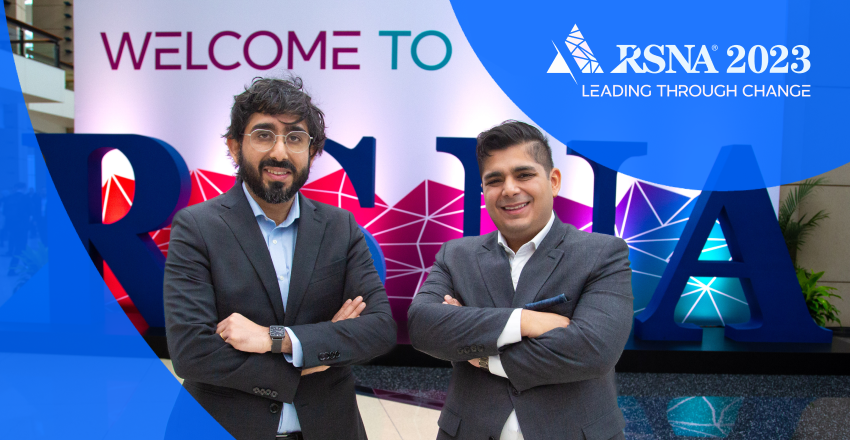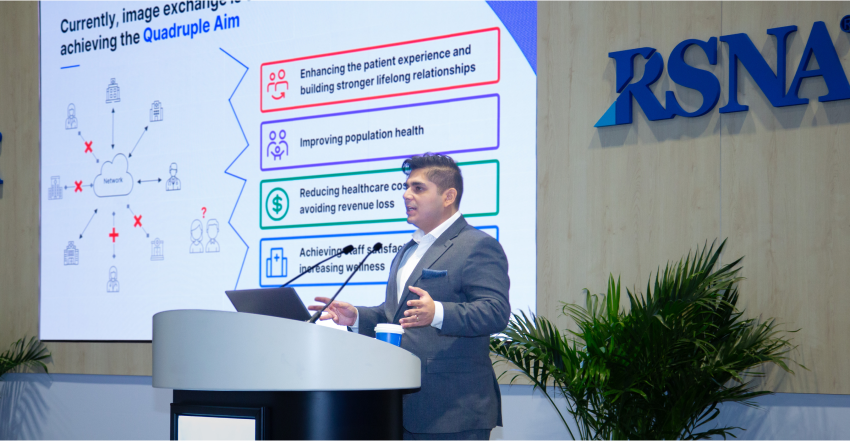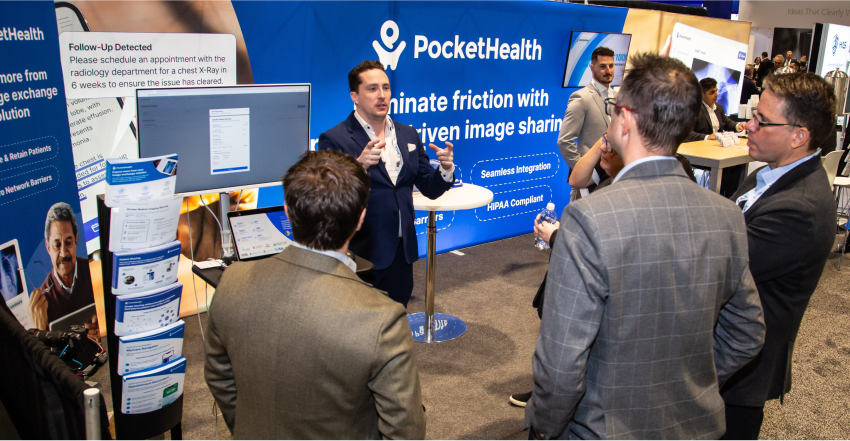2023 RSNA Conference: Trends and Themes
Published on: December 4, 2023 | Rishi Nayyar
PocketHealth CEO discusses the future of medical image exchange and takeaways from RSNA 2023.
From November 26-29, I had the opportunity to attend and present at the 2023 Radiologist Association of North America (RSNA) Annual Meeting in Chicago. With over 30,000 radiology professionals and healthcare leaders, this year’s RSNA conference was another memorable experience. I enjoyed meeting our provider partners and having conversations with other health professionals about this year’s theme: leading through change.
RSNA 2023 highlighted the importance of being intentional and innovative while leading teams through transition periods. Through theater presentations, exhibitions, lunch and learns and educational sessions, three major themes emerged:
 Transforming the future of healthcare
Transforming the future of healthcare Combatting staffing shortages
Combatting staffing shortages Simplifying image exchange with AI
Simplifying image exchange with AI
Below, I provide an overview of key trends and takeaways from the conference.
 Transforming the future of healthcare with patient-centric image exchange
Transforming the future of healthcare with patient-centric image exchange
During RSNA 2023, PocketHealth had the pleasure of hosting a Lunch & Learn titled Rethinking Image Exchange: An Untapped Opportunity to Deliver on the Quadruple Aim. Industry experts Aimée Langan, William Osler Health System; Seetharam (Ram) Chadalavada MD, MS, University of Cincinnati & UC Health; Ajay Kohli, MD, MBA, UT Southwestern Medical Center & Parkland Health and Frank Manole, DNP, MBA, Raleigh Radiology joined us to discuss how human-centricity enables delivery of the following Quadruple Aim goals:
- Improving population health
- Reducing healthcare costs and avoiding revenue loss
- Enhancing the patient experience
- Improving staff and clinician satisfaction

Lunch & Learn panelists from left to right: Seetharam (Ram) Chadalavada, Aimée Langan, Ajay Kohli and Frank Manole with Rishi Nayyar, CEO of PocketHealth.
The Lunch & Learn produced many insights on addressing healthcare challenges and shaping its future. Panelists agreed that redesigning image exchange systems can help providers navigate structural challenges and make progress on the Quadruple Aim goals.
As imaging often marks the beginning of a patient’s journey, panelists viewed the image exchange process as a crucial opportunity to build trust, strengthen the patient-provider relationship and drive patient loyalty. Positive patient experiences also lead to patients returning to and recommending an organization, resulting in significant cost savings.
These sustained patient relationships translate into tangible benefits—they reduce staff intervention, simplify complex image sharing workflows and create operational efficiencies. For example, William Osler Health System (WOHS) went to zero CD and redirected front line workers to more critical tasks after adopting a patient-centric image exchange solution. By focusing on medical imaging and investing in a patient-centered image exchange solution, providers can both empower patients and break free of image access barriers to achieve the Quadruple Aim.
Educational sessions at RSNA also emphasized the importance of patient-centricity. Plenary Session: The Future of Healthcare Delivery: Considerations for Patients and Provider explored the impact of technology on healthcare, offering insights into current and future trends. This session also focused on making home care as easy and accessible as possible for patients.
A session on Informatics and Patient-Centered Care focused on the role informatics innovations play in enhancing the patient experience and promoting family-centered care. Panelists discussed transparent pricing, follow-up recommendations, and incorporating patient feedback as possible strategies.
When combined into a centralized solution, these strategies create an integrated patient experience and enhance engagement. For example, PocketHealth’s MyCare Navigator increases follow-up adherence, improves communication and provides screening tools to keep patients on track with healthcare systems.
According to a 2023 survey, 83% of patients who have used PocketHealth say it’s given them a better understanding of their health. Patient-driven image sharing also greatly benefits patients’ overall care journey — 89% of patients say it’s improved their healthcare experience. By involving patients in the image exchange process and giving them the access, knowledge and tools to become engaged participants in their care journey, organizations can better support patients and transform the future of healthcare.

PocketHealth CEO, Rishi Nayyar presenting practical solutions to overcoming network barriers and achieving the Quadruple Aim through patient-driven image exchange at the RSNA Innovation Theater.
 Combatting staffing shortages
Combatting staffing shortages
Staffing shortage, a pressing issue within healthcare, was a central discussion point at the RSNA conference. According to the American Hospital Association, health organizations may face a shortage of 124,000 physicians by 2033 and up to 450,000 nurses by 2025. Staffing shortages lead to higher levels of dissatisfaction and burnout among staff and physicians.
When healthcare organizations are understaffed, the existing workforce has to shoulder additional responsibilities, which can strain resources and exacerbate inefficiencies in various processes, including image exchange. Without consolidation of solutions, staff have to learn and execute on multiple systems, which adds to the cognitive workload when onboarding new staff and dealing with turnover. This can affect workers’ physical and mental health as addressed in the Shift Work and Mental Health Among R.T.s RSNA lecture. The lecture stressed the importance of assessing and managing mental health among Radiology Technologists.
To maintain a patient-centered approach and prevent staff burnout, healthcare organizations can prioritize solutions that save radiologists’ time and bandwidth. This begins with identifying critical activities that align with organizational goals and automating additional tasks that consume staff time and energy.
One course at RSNA, Structured Reporting – Why, How, and Future Directions, explored the impact of structured reporting on enhancing clinical decision-making, improving communication, promoting standardization and improving quality of care. Structured reporting removes inefficiencies in medical image exchange that contribute to staff dissatisfaction. By using standardized formats, lexicons and templates, structured reporting streamlines the reporting process, ensuring consistency and easing burnout. Clear and concise reports enhance communication between staff and minimize misunderstandings that create additional responsibilities. It also facilitates data analysis and quality control, leading to process improvements that result in a more sustainable work environment.
Removing manual processes between teams and outside care providers requires patient-driven solutions that drive efficiencies. This improves the staff experience and allows resources to be redirected to more impactful tasks. To combat staff shortages and increase satisfaction, health organizations can choose solutions with:
- Appointment reminders to reduce outbound calls
- Automated follow-up notifications that result in fewer callback reminders
- Report reading tools to decrease the number of admin questions from patients
- More efficient image exchange to eliminate CDs and complex workflows. E.g., PocketHealth for Providers
As evidenced by a 2023 PocketHealth survey, patient-centric solutions greatly reduce administrative tasks — 78% of patients agree that having access to their reports through PocketHealth results in asking staff fewer questions.

PocketHealth Enterprise Sales Director, Ryan Anthony walking through a demo of PocketHealth on the RSNA conference floor.
 Simplifying imaging exchange workflows with AI
Simplifying imaging exchange workflows with AI
Effective AI solutions help healthcare organizations reduce workloads, enhance staff efficiency and boost productivity. RSNA 2023 featured many informative sessions about AI solutions. The Symbiotic Relationship of AI and Patient-Centered Radiology discussed patients’ perspectives on AI and its impact on their care.
Another session, Accelerating to the Future of AI in Radiology: A Demonstration of Imaging AI in Practice, outlined semantic and interoperability standards for successful AI application into clinical practice.
In Connecting Imaging Systems, Workflows, and AI: An Overview of IHE Radiology, attendees gained insight into the role of IHEs in connecting the radiology technology ecosystem.
These sessions demonstrated the potential of AI to transform healthcare delivery. Effective AI tools not only improve care delivery but can also help healthcare systems better engage and retain patients. According to a report by HealthITAnalytics, one-third of hospitals and imaging centers have already integrated AI into patient care and business operations, with 27% of these organizations leveraging AI to optimize their workflows. AI in radiology contributes to workflow efficiencies and reduces the risk of misdiagnosis and analytical oversights.
While AI tools simplify workflows, centering patients must remain a priority. AI can transform the patient experience by providing patients with the knowledge and tools to make informed decisions about their care. Solutions that improve communication while also empowering patients to take an active role in their care journey will lead to greater adoption and transform the future of healthcare.
Ongoing conversations about developing patient-centered solutions, combatting staff shortages and streamlining radiology processes with AI are changing the way we approach healthcare. After reflecting on the highlights from RSNA23, I’m excited about how we can use these insights to improve image sharing for our patients, physicians and provider partners.




